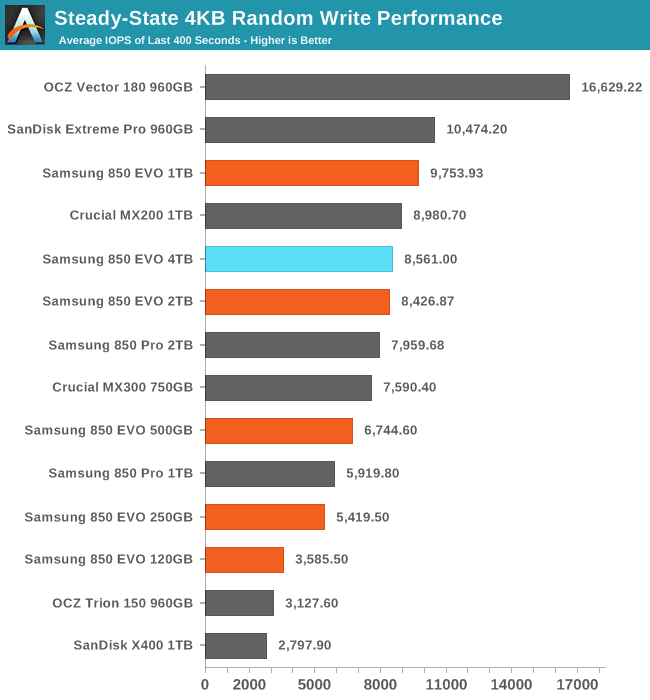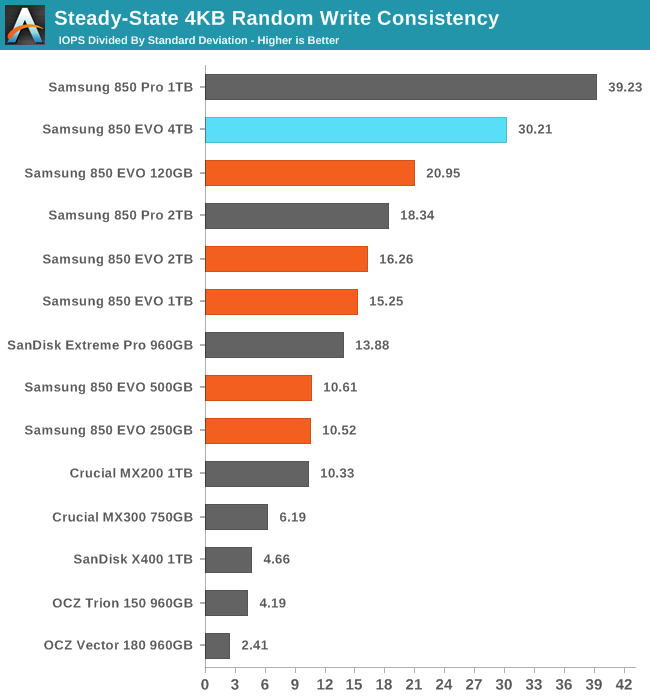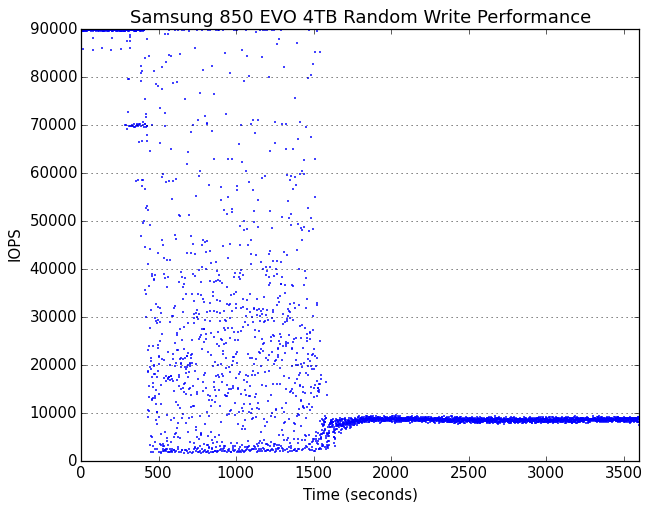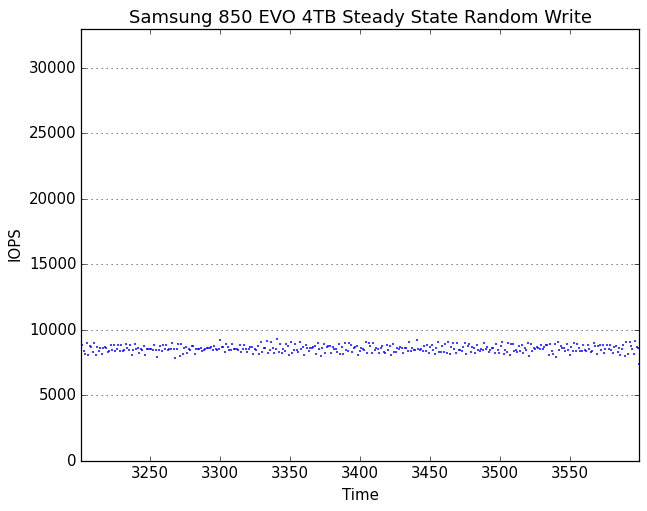The Samsung 850 EVO 4TB SSD Review
by Billy Tallis on July 11, 2016 10:00 AM ESTPerformance Consistency
Our performance consistency test explores the extent to which a drive can reliably sustain performance during a long-duration random write test. Specifications for consumer drives typically list peak performance numbers only attainable in ideal conditions. The performance in a worst-case scenario can be drastically different as over the course of a long test drives can run out of spare area, have to start performing garbage collection, and sometimes even reach power or thermal limits.
In addition to an overall decline in performance, a long test can show patterns in how performance varies on shorter timescales. Some drives will exhibit very little variance in performance from second to second, while others will show massive drops in performance during each garbage collection cycle but otherwise maintain good performance, and others show constantly wide variance. If a drive periodically slows to hard drive levels of performance, it may feel slow to use even if its overall average performance is very high.
To maximally stress the drive's controller and force it to perform garbage collection and wear leveling, this test conducts 4kB random writes with a queue depth of 32. The drive is filled before the start of the test, and the test duration is one hour. Any spare area will be exhausted early in the test and by the end of the hour even the largest drives with the most overprovisioning will have reached a steady state. We use the last 400 seconds of the test to score the drive both on steady-state average writes per second and on its performance divided by the standard deviation.

The 4TB 850 EVO restores a little bit of the performance that the 2TB lost relative to the 1TB, but Samsung's controller architecture is still clearly most comfortable at 1TB.

The consistency of the 2TB 850 EVO was only slightly better than the 1TB EVO, so it's surprising to see the 4TB model make such a large jump and come so close to the 1TB 850 Pro.
 |
|||||||||
| Default | |||||||||
| 25% Over-Provisioning | |||||||||
It is no surprise that a 4TB drive lasts so long before dropping out of peak performance: it has far more spare area to burn through than any ordinary consumer SATA SSD. The transition to steady state is uncharacteristically long and messy for a Samsung drive, and the performance lows during this period are disappointing. Once the drive has reached steady state, there's nothing to complain about.
 |
|||||||||
| Default | |||||||||
| 25% Over-Provisioning | |||||||||
There are no wild outliers from the 4TB 850 EVO's steady-state, and none of the longer-term drift in performance shown by the 1TB and 2TB 850 EVO and Pro models. With extra overprovisioning, the 4TB EVO carries on indefinitely with high and extremely steady performance.










145 Comments
View All Comments
Adm_SkyWalker - Monday, July 11, 2016 - link
At CES Mushkin said they were planning on releasing a 4TB SSD by the end of the year. They are targeting a $500 price point. Unless they scrapped it, this could be a cheaper option before the end of the year.http://techreport.com/news/29583/mushkin-previews-...
http://techreport.com/news/29583/mushkin-previews-...
Kristian Vättö - Monday, July 11, 2016 - link
It was a misinterpretation. The $500 price point was for the 2TB drive, with the price of the 4TB being unannounced (likely a double at least).http://www.anandtech.com/comments/9986/ces-2016-ro...
Adm_SkyWalker - Tuesday, July 12, 2016 - link
I should of figured it was to good to be true. Still a competing $1000 drive could convince Samsung to lower their price. Assuming the speed is comparable between the two.aggiechase37 - Monday, July 11, 2016 - link
Way WAY WAAAAYYY too expensive. For this price you could get piece together a RAID configuration out of regular HDD and get a decent amount of the same performance AND the added bonus of having redundancy in the case of a drive failure. Can't see who purchases this.Chloiber - Monday, July 11, 2016 - link
Not sure why anyone would want to buy this when you can get a 4TB Samsung P863 Enterprise SSD for 300$ more...Taracta - Monday, July 11, 2016 - link
Isn't the 25% over-provisioning getting a bit much for these larger SSDs? Does a 4TB SSD really need 1TB over-provisioning to max-out relative performance? Would 10% be enough for these large drives?Billy Tallis - Monday, July 11, 2016 - link
That is something I've wondered about and will probably look in to eventually, but it would be pretty time consuming to test and isn't something I can see adding to the routine suite of benchmarks.Impulses - Monday, July 11, 2016 - link
Something to ask Samsung tho?Taracta - Thursday, July 14, 2016 - link
Thanks for your reply. I believe that you should just test this 4TB SSD for now to see the impact and another couple of different ~4TB SSDs when available to compare with these results. Forget about the lesser drives, too many and too late.ACE76 - Monday, July 11, 2016 - link
hopefully we see more manufacturers release 4tb and greater SSDs...these drives will end the need for platter based hard drives for good...price is too high right now but it should come down over the next 6 months to a year.